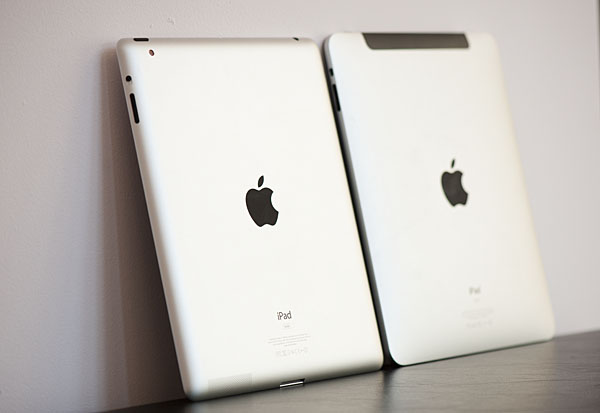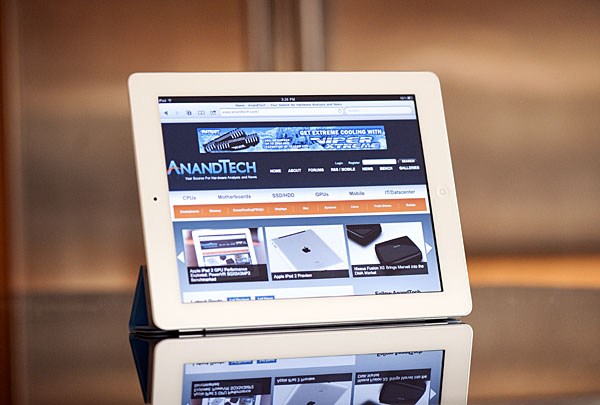The Apple iPad 2 Review
by Brian Klug, Anand Lal Shimpi & Vivek Gowri on March 19, 2011 8:01 PM ESTIndustrial Design & The Future
The original iPad was a device followed by so much hype and anticipation that inevitably, upon launch, it became one of the most polarizing products to launch in the last few years. It also became a huge hit, infusing life into the previously flatlining tablet market, and that's where the iPad 2 comes in.
The industrial design changes are very much in line with what we saw with the 4th generation Apple handhelds. The design language used for the iPhone 3G/3G-S and iPod touch 2G/3G was based on accelerating curvature continuity (known as G3 continuity in industrial design terminology), in contrast to the tangentially continuous design (G1 continuity) found on the original iPhone. What this meant, basically, is that the first iPhone had a relatively flat design, whereas the 3G/3G-S had a gently crowned back that aimed to fit the contour of one's hand.
The original iPad foretold the future of Apple's design language, using a similarly curved back but dumping the blended G3 curvature on the sides for hard edges that met the front face in a perpendicular manner. The iPhone 4 went a step further, with a flat back in addition to the sides. The front profile kept the same rounded corners that every other Apple device has, but the top and side cross-sections end up being rectangles, with all four faces meeting perpendicularly. I'm thinking Apple chose to do this to accomplish two things: being able to use glass for both the front and back faces, as well as to give the iPhone line some separation from the iPod and iPad lines.
The fourth generation iPod touch reaffirmed the notion that Apple was moving back to flatter, more rectangular designs. The use of aluminum instead of glass meant that there wasn't a need for a completely flat back; the predominantly flat back of the iPod tapers to meet the front face at the edges using a short continuous curve.
After seeing the newest iPod touch, I guessed that the second generation iPad would carry rather similar lines. I definitely didn't expect the iPad 2 to be so thin, but overall, it was pretty much in line with what I was expecting.
Another significant aspect to the industrial design changes is the addition of a white-bezeled iPad. The back of both black and white models are the usual anodized aluminum, though the texture of the anodizing on the iPad 2 (as well as the latest MacBook Pros) seems to be a different, smoother one than on previous aluminum Apple devices. Apple seemed to have moved to black bezels on almost all of its products, other than the vaporware-esque white iPhone 4, but between the iPad 2 shipping in white and a promised spring release for the white iPhone 4, it shows that Apple is trending back towards white devices.
The interesting question to ask here is how much we can read into Apple's future designs given the iPad 2, and unfortunately, that isn't a whole lot. It's always difficult to tell with Apple, but it wouldn't surprise me if the iPhone 5 ended up using a very similar design to the iPhone 4. Since the antenna problem is mostly solved (see the antenna diversity on the Verizon iPhone 4), Apple probably doesn't need to do a whole lot to the design for the next generation iPhone. Other than the signal attenuation issues, the iPhone 4 was an amazing piece of hardware, one that Apple spent a lot of money developing. It doesn't make sense for them to turn around and dump it on another ground-up redesign, especially when the 4 is still very competitive from a hardware standpoint. And at this point, I doubt they would focus so much on releasing the white iPhone in spring if they weren't planning on using a very similar chassis for the iPhone 5 that should launch in June.
Given past history, if the iPhone doesn't get a redesign, neither will the iPod touch. Both of the generation 5 handhelds will probably get some form of the A5 SoC, potentially underclocked like the A4 in the iPhone 4. What is more difficult to predict is the 3rd generation iPad. Since we don't really have an established cadence for the iPad, it's hard to say anything about the iPad 3 without reading too much into the iPad 2 launch. I'd say its safe to assume there will be a 6th generation Apple SoC (presumably named the A6), and if I was a betting man, my money would be on at least some form of redesign or at least an ID refresh, but again, with Apple, you really never know.













189 Comments
View All Comments
Mike1111 - Sunday, March 20, 2011 - link
Well, Anandtech is a site for geeks, but shouldn't you have at least mentioned how you think the iPad 2 could fit into the average person's life? People who don't "work" with PCs in their free time and who don't have a dedicated PC workflow?Some thoughts regarding the review:
- I thought the glass was supposed to be from Asahi Glass (Dragontrail)?
- Okay, the Xoom can't play videos with b-frames without problems. But what h.264 videos can the iPad 2 play? Same as iPad? More? High-profile? Blu-ray class h.264 videos?
- I wish you could have gone more in-depth regarding the A5. Why is it so big compared to the Tegra2? How efficient does it work? What kind of video decoder/encoder are used? etc.
Zebo - Sunday, March 20, 2011 - link
Nothin like the real things baby.....I have used a x201 tablet since April of 10 and it's the best investment I ever made. True outdoor viewable with upgraded outdoor IPS screen and 500 nits. true keyboard, true duel core processor, true work machine. I have ATT card to get internet and take it everywhere I go. I bet I travel more than Anand and it's the only way to fly.tcool93 - Sunday, March 20, 2011 - link
I don't even own the Ipad. Yet I do know for a fact there are at least two other browsers you can use with it besides Safari. The Atomic browser, and the Skyfire browser... both supporting tabs and supposedly are much better than Safari. Skyfire even has partial flash support, and viewing social network sites built in (twitter, facebook, etc). Both of those browsers have very good reviews also.secretmanofagent - Sunday, March 20, 2011 - link
I'm starting to play with iCab, but I don't have an iPad.dagamer34 - Sunday, March 20, 2011 - link
3rd party browsers unfortunately don't get the Javascript speedup built into iOS 4.3tipoo - Sunday, March 20, 2011 - link
The javascript engine is built into the browser. Of course they don't get the faster Safari engine, they aren't Safari. They use their own engines.name99 - Sunday, March 20, 2011 - link
Yes and no.The current iOS will no allow third party apps to create code on the fly, so those browsers will not be able to use JIT'ing, even if they wanted to write a sophisticated javascript engine.
On the other hand, Apple is well aware of the limitations of their current browser tech and are actively working on ways to run different parts of the browsing code in different processes (for both performance --- multi-threading, non-blocked UI --- and security reasons), on both OSX and iOS.
When this effort comes to fruition, who knows how much of the underlying tech (in particular, in this case the ability to create code on the fly, perhaps in some sandboxed fashion) will be made available to devs?
Zebo - Sunday, March 20, 2011 - link
You'll never even think about a slate tablet after that.10 hrs battery
all windows apps
plays games
IPS screen (with upgrade)
can use as HTPC when on road
can publish this site effortlessly
I doubt you'll use a another device besides your iphone
VivekGowri - Sunday, March 20, 2011 - link
And I could buy three iPads for the same price. It simply isn't a valid comparison for the same reason the MB Air, Asus Slate, and other $1000+ devices aren't; not in the same category, not even in the same price range. It's like saying that after driving a Mercedes S-class, you'll never think about driving a Lotus Elise or Porsche Boxster ever again - it's not really a useful or valid comparison to make.I don't doubt that the X220t is going to be an excellent, excellent device - fixes every problem I had with the X200/201t, goes back to the IPS display, and it's going to be pretty fast too. It looks pretty awesome, IMO. If I was in the market for a tablet PC (as opposed to a smartphone-based tablet), this and the ASUS Slate would be the only two I'd really look at - the ASUS is kind of like a cheaper version of the X220 except without the built-in keyboard.
snouter - Sunday, March 20, 2011 - link
But I left it on a plane. What did I replace it with? An 11" MacBook Air. Honestly, it's no comparison. The Air can do so many things that the iPad could not. Tablets will stick around and find niche applications in lots of places, but I'd keep my eye on the the super thin super light notebooks. BTW, the Air has a ULV Core 2 Duo 1.6GHz and will get Sandy Bridge in the next update. The processing power is far superior to the tablets and the netbooks. It's everything I wanted to do with my iPad, and it's a notebook when I need it to be. Main main work Laptop is still a 17" MacBook Pro, but none of these tablets, netbooks or ULV laptops are in competition with it. When the next Air comes out with a backlit keyboard and ULV Sandy Bridge, I'll be there.